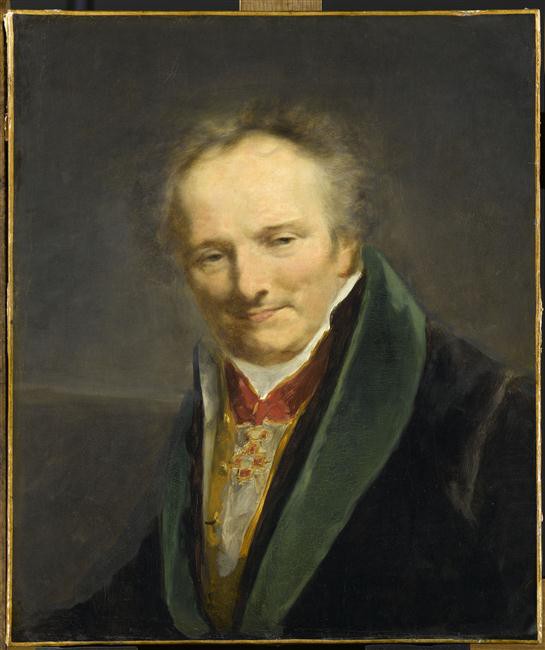Denon, one of the key figures in the artistic world of the First Empire, was born in Givry, near to Châlons-sur-Sâone in Franche Comté, 4 January 1747 into a family of the lesser nobility. At eighteen he went to Paris to study not only law (his parents wanted him to be a magistrate) but also drawing and engraving. At the same period he found time to write a three-act play entitled Julie et le Bon Père (1769). Never performed, it was Denon’s first and last experiment in the genre.
It is not known how, but he came to the notice of Louis XV and in 1769 was put in charge of the collection of engraved stones belonging to the Marquise de Pompadour. He subsequently became a ‘gentilhomme ordinaire de la Chambre du Roi’. It is similarly unknown as how he became a diplomat, but his first diplomatic mission was to Saint Petersburg in 1772 where he was to remain for two years. His second post was in Stockholm where he became the secretary of ambassador Vergennes, and when Vergennes later became Minister for Foreign Affairs he was to be important as Denon’s powerful protector. In 1775, during his third mission, this time to Switzerland, he went to Ferney where he met and became friends with Voltaire – indeed Denon was to engrave Voltaire’s protrait.
In 1777, he published a libertine novel, signed MDGODR, entitled Point de Lendemain, which was republished several times. His diplomatic career however then took him to Naples. Whilst there he visited much of southern Italy, Rome, Sicily and Malta, all the time observing the art and producing his own drawings and engravings. When his diplomatic career was ended at the request of the Queen of the Two Sicilies, he returned in 1785 to Versailles, where with his diplomatic pension and his family inheritance he could afford to live the life of a gentleman and thenceforward dedicated himself entirely to the fine arts.
In 1787 he entered the Académie as an engraver and in the following year he went to northern Italy, Venice and Florence where he lived for five years. But on the outbreak of the Revolution after figuring on the list of émigrés, he returned to Paris with the Terreur in full swing. It would appear that his friendship with David (whom Denon had known in Naples and who had become an ardent sans-culotte) played a great part in Denon’s avoidance of the guillotine. Remarkably enough, Denon became the regime’s state engraver. When 9 Thermidor changed the situation, Denon returned to his society life.
It seems that Denon got to know Bonaparte via Josephine whose salon Denon frequented. He embarked with Bonaparte at Toulon for the Egyptian Expedition. He became a founder member of the Institut d’Egypte, accompanied Desaix into Upper Egypt and was one of the few members of the expedition to return to Paris with Bonaparte in 1799.
In 1802, Denon published his Voyage dans la Basse et Haute-Egypte, the fruits of his research during the Egyptian Expedition. On 24 November of the same year he was nominated director of the recently reorganised Musée central de Arts. Shortly afterwards on 28 January 1803, he entered the Académie in the Beaux-Arts class, in the painting section. He was now considerably powerful as the head of the museums of the Louvre (soon to become the Musée Napoléon) and of Versailles, and director and overseer of French monuments; he was head of the galleries of the Palais du Gouvernement, the Monnaie des Médailles, director of engraving and etching, and in charge of the acquisition and transport of works of art; he was also director of the manufactories of Sèvres, Gobelins and the Savonnerie. All he lacked was control over architecture.
Nor did he not rest there. He became Napoleon’s ‘arbiter elegentiae’, distributing the Emperor’s commissions, recommending acquisitions at the various salons, accompanying the Emperor on his various campaigns helping him choose the works of art which would be the trophies and which would grace the Musée Napoléon, the richest and best organised museum in the world at that time.
With the first fall of the Empire and the first Restoration, his position remained unchanged. Indeed, even after the Cent-Jours he retained his position and oversaw the negociations with the allies over the restitution of art treasures. His last days were spent in Paris in his house on Quai Voltaire amongst his beloved art collection. He died suddenly on 28 April 1825. His collection was dispersed in 1826, three years before the descriptive catalogue was to be published in 1829.
He was a remarkably ugly man, but whose enormous learning and great charm made him exceedingly popular in the salons. Most all, as is shown through his published work on Egypt, he was a man of gigantic energy and great ability whose life marked the history of art in France of the period and beyond.


